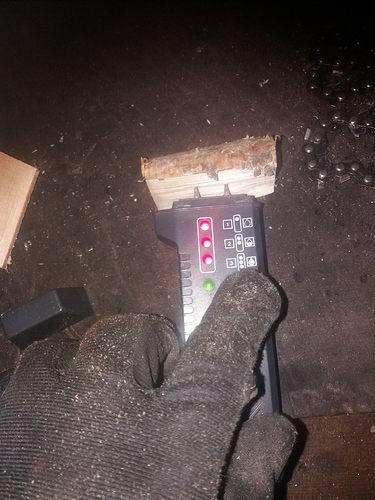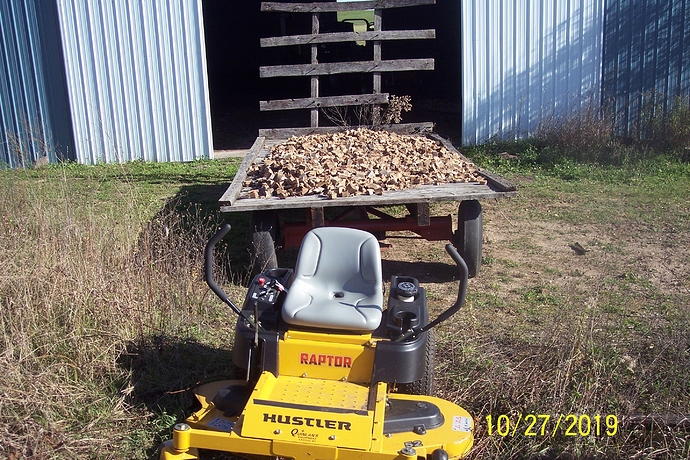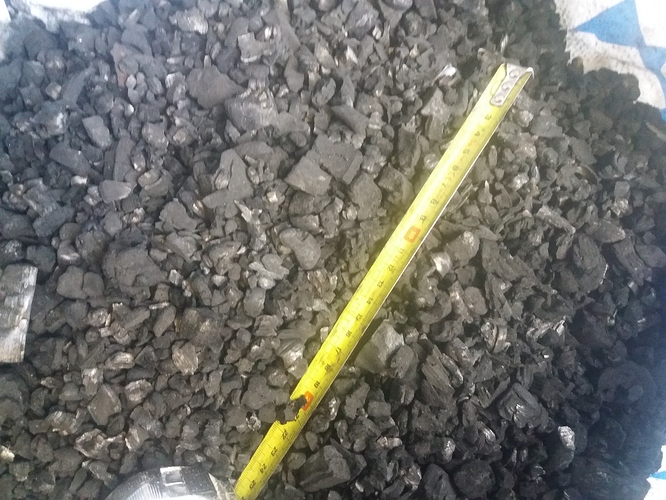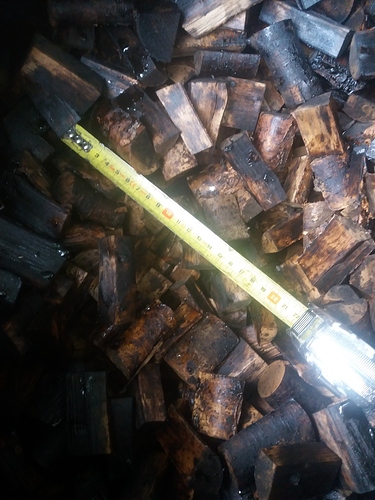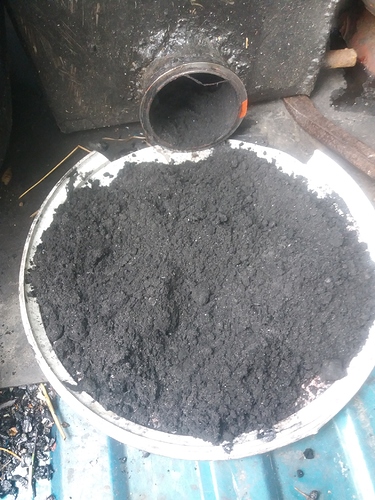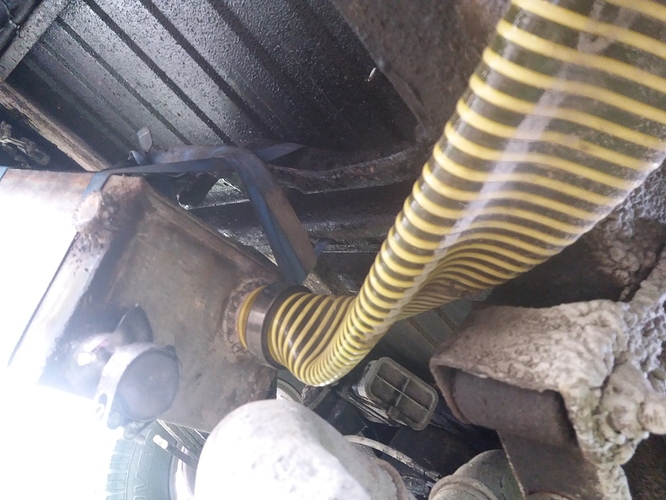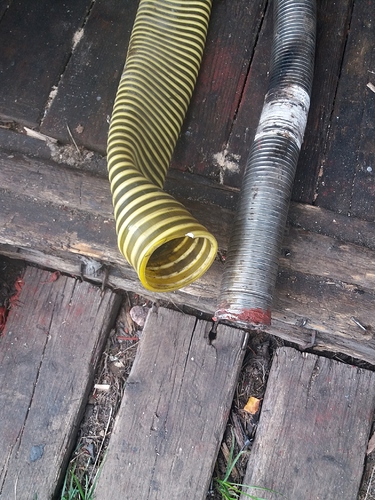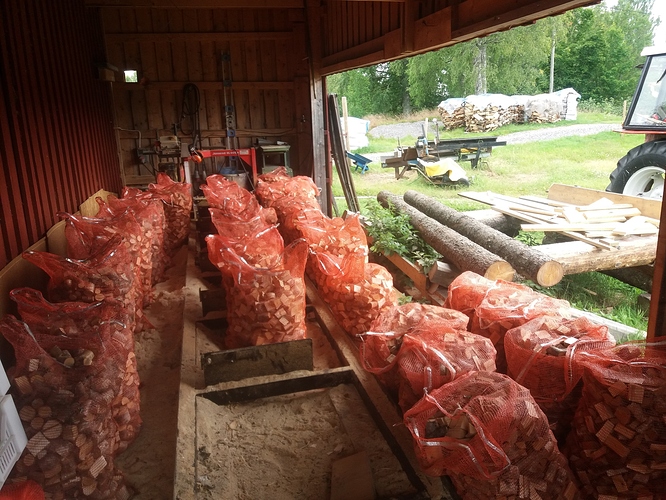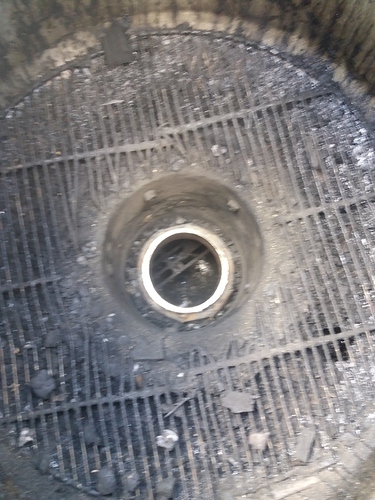Jan; I am going to make one more WAG (wild ass guess). That wood is only charred on the very outside. And yet there are signs that you had flames up in that area (white ash on a few edges). I going to suggest that this wood is NOT dry enough. Take two pieces that a close to identical size of the same limb. Put one in the oven for about 1 1/2 hours at 110C. When done compare the weight of the two pieces. How high above the nozzles was the ruler in this picture? TomC
Hi Tom.
I tested with the moisture meter, and it showed no moisture.
Think it’s around 30cm (16 ") over the nozzles.
Jan; I don’t have much faith in those meters. They tell you the moisture between the two probs but not deep in the wood. Please try the test I suggested.
The wood in the hopper 16 inches above the nozzles should be dry and maybe a little brown, but not chared and certainly not burnes with white ash. I don’t know your prosedure for starting the gasifier, but looking at the picture, it looks like you are “blowing” the flames from the nozzles way up into the hopper. That is why I think the wood is wet. You should only have to blow a short time. Most of the start-up should be pulling the flames and hot gas down into the char. I’m going to say that “good” char is small and solid carbon. I think because of the size it is falling through your grate or off over the sides. What is left below the nozzles to light are partially cured charcoal. ( not broken into small pieces and having some un-chared wood still inside.
Again I suggest fixing your grate and getting for sure dried wood.
My Dried Wood ( this is Oak ).
Wood Drying ( I pull it in and out depending on the sun )
Looking Into the Hopper ( about 2 inches above nozzles )
TomC
Hi Tom.
As I wrote, I think you are right that the wood is wet.
This is what the same wood looks like in the hopper when I made smaller pieces of it, about the same height above the nozzles.
The coal under the nozzles looks like this down to the bottom of the fire pipe.
The ash in the cyclone looks like this, do you think I need to change the grate then
Jan, the wood in the hopper looks good to me. Chunks turn black mostly because they sweat tar.
If pic no1 shows char raked out from under the grate I would say it’s a normal size.
It’s a balancing act. Ideally you would want the grate slots to be a bit tighter when running hard for a long period if time and wider at light work. Same thing with fuel size. Hard work - small chunks. Light work - big chunks.
The moist dust in the cyclone is puzzling though.
Picture number 1 shows the carbon that is between the nozzles and the bottom of the fire tube, ie in the hearth.
Do you not think that the moisture in the ash under the cyclone is due to some wood being very wet, if you look at the meter in the picture above it shows 3 red lights, which means very wet.
Moist wood is not good of course, but the cyclone should keep hot enough not to condence the steam.
I was thinking in terms of air leaking in cooling things or even burning gas creating access steam. Just guessing here.
Hi @TomC
The wood you have in the buckets, do you drive with the pieces, how big are they, and what temperature do you have in the top of your hopper when you drive
Jan, take a look at those chunks. Look at how butyfully fractured the wood comes out of those style chunkers. The fractures help dry the wood but allso disintigrate much better in the gasifier.
Trying and Trying, tested with dry birch today, it went a little better, 90km / h but still weak on the slopes.
Looked at the new hose I put there yesterday, does not seem good, wondering if I can put the stainless steel hose inside?
The soot in the picture is from about 80km, no carbon pieces at all.
Chopped some small pieces, now I have to wait for them to dry.
Tom Collins it is great that you are sharing your specific 4.3L v-6 information with JanA.
JanA. Indeed hoses are a gasifer-mans nightmare.
Your lefthand pictured one has heat and suction collapsed, as you are aware.
And the righthand pictured one will suction air leak at the spiral metal overlaps.
A fellow can drive himself crazy over wood gas proof hoses.
The longest useable fix is to take the metal spiral hose and over-wrap the outside with aluminum foil tape to make it hot gas tight.
This tape is used in cothes drier exhaust vent tubing joints sealing.
Regards
Steve Unruh
Next to your boiler I guess. With everything dripping wet until noon, drying is hard this time of year ![]()
No need. The ss hose is enough. Leaking in just a little air doesn’t hurt anything. You will be mixing in 50% a few seconds later anyway ![]()
As long as the empty space under the grate is wide enough the char will stay put. As soon as char starts showing up in the cyclone it’s time to rake out under the grate.
The problem is that the yellow hose is 64mm inside and the stainless steel hose is 50mm inside.
Tips: Hard plastic 3" sewer piping should be about 66mm ID and cutt-off rings of tire inner tubing work good for seals.
I drove a bit tonight and tested the plastic hose with steel hose in, it seemed to work had not sucked the hose together.
I drilled in the heat probe in the pipe after the cyclone, the thermometer only goes to 250 degrees-c, it seems to be between 230 to over 250 degrees-c.
Is this normal?
Sounds like normal open road temps to me.
Every system is different, but I back off when I see temps above 300C coming out of the cyclone.

